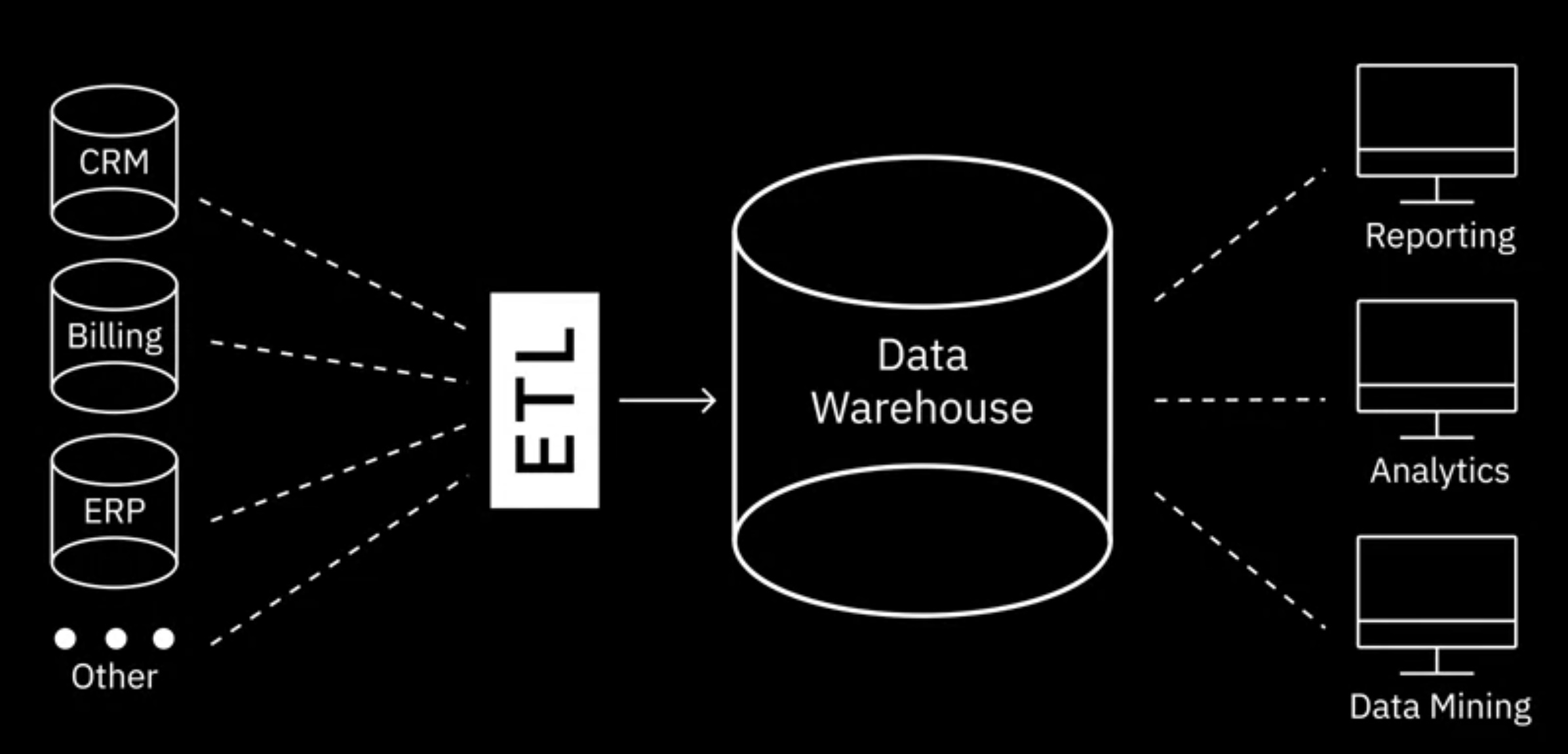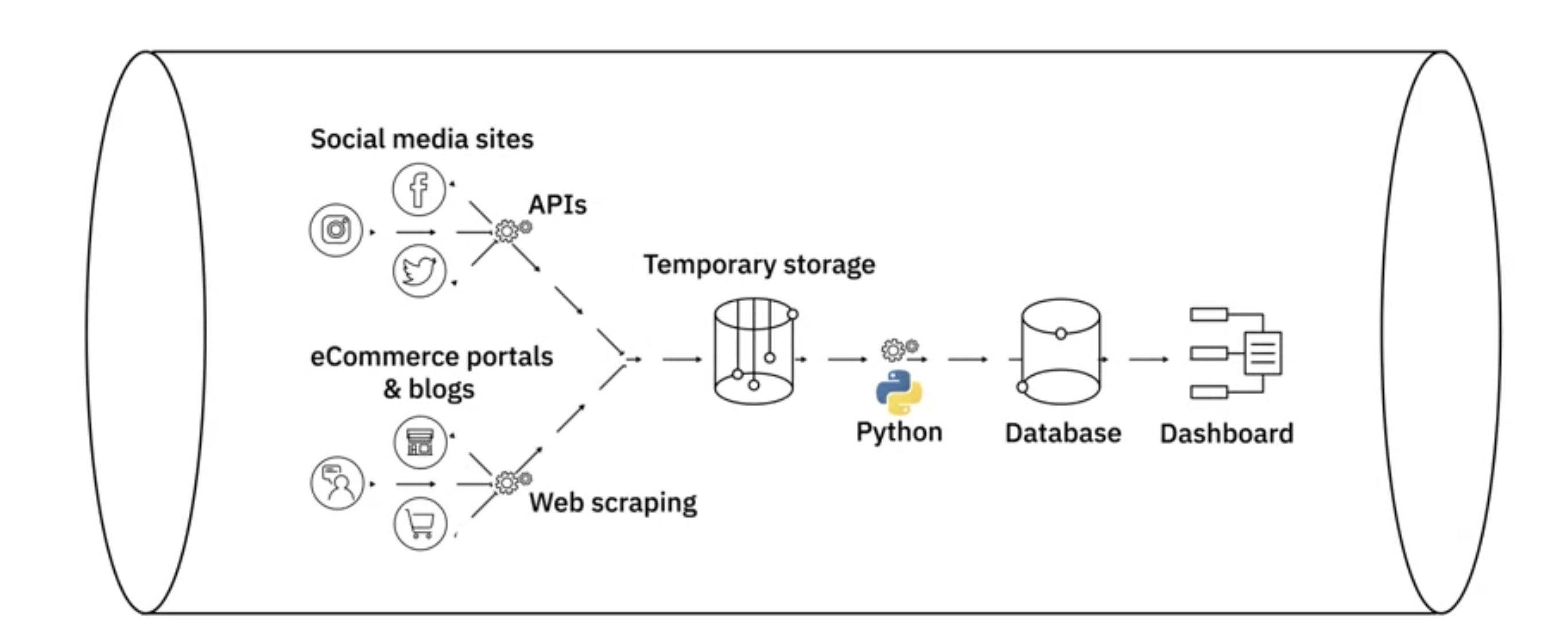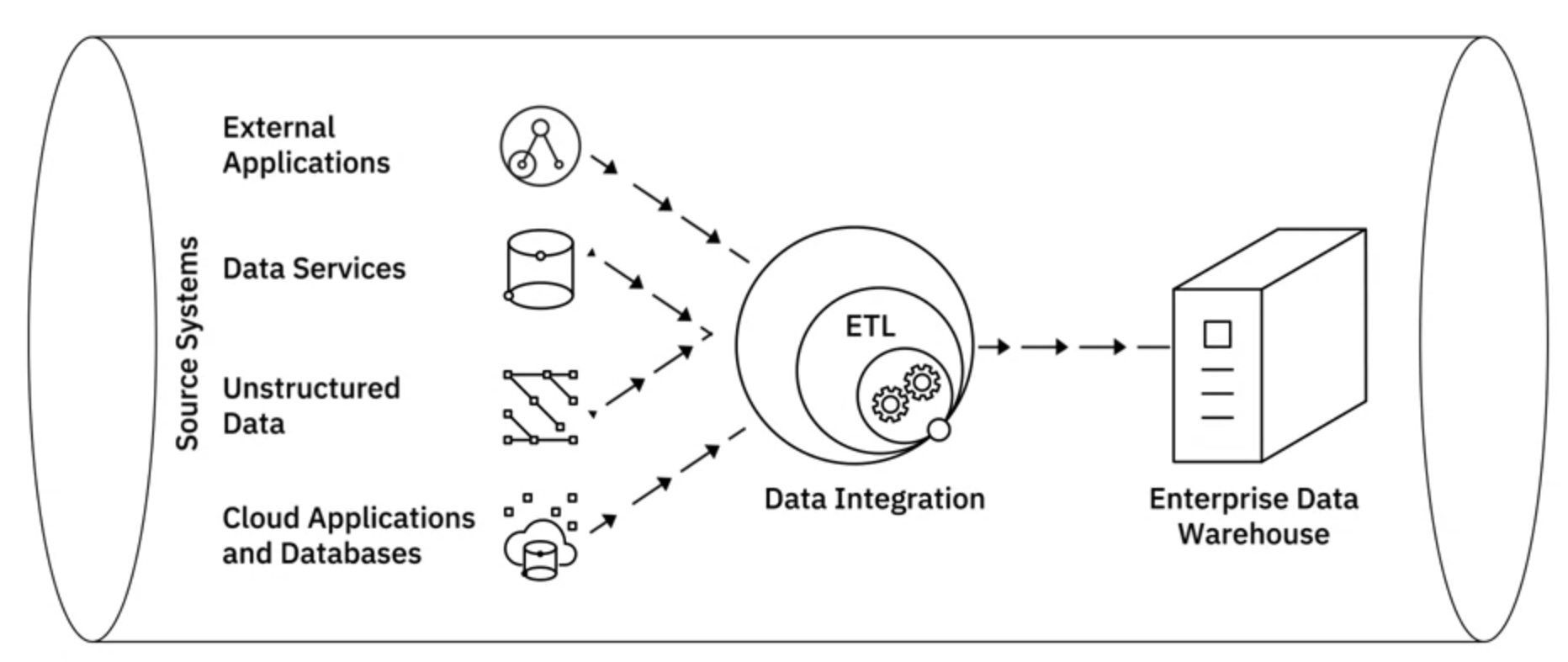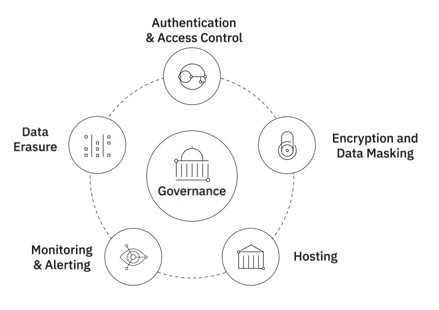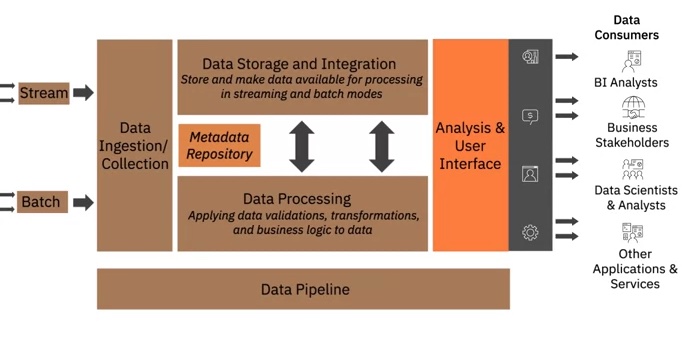Data-Engineering
for Interview preparation & for Beginners
The field of Data Engineering concerns itself with the mechanics for the flow and access of data. Its goal is to make quality data available for fact-finding and data-driven decision making.
Data Engineers:
- Designing, Building, Maintaining data infrastructures and platforms
- Develop and optimize data systems
- Make data available for analysis
Data Analysts:
- Analyze data in data systems to report and derive insights
Data Scientists:
- Perform deeper analysis on data
- Develop predictive models to solve more complex data problems
The field of Data Engineering involves:
- Collecting source data (Extracting, integrating, and organizing data from disparate sources)
- Data acquisition from multiple sources
- Data architecture for storing source data
- Processing data (Cleaning, transforming, and preparing data to make it usable)
- Distributed systems for processing data
- Pipelines for extracting, transforming, and loading data
- Solutions for safeguarding quality, privacy, and security of data
- Performance optimization
- Adherence to compliance guidelines
- Storing data for reliability and easy availability of data
- Data stores for storage of processed data
- Scalable systems
- Ensuring data privacy, security, compliance, monitoring, backup, and recovery
- Making data available to users securely
- APIs, services, and programs for retrieving data for end-users
- User access through interfaces and dashboards
- Checks and balances to ensure data security
Languages needed for Data Engineers
-
Query languages:
- SQL for mostly relational databases we use mostly for:
- NoSQL or SQL-like query languages for NoSQL databases
-
Programming languages
- Python, R, Java
-
Shell and Scripting languages
- Unix/Linux Shell and PowerShell
-
Big Data Processing Tools
- Hadoop (for Big Data)
- HIVE
- Spark Apache
Data
Data Forms:
- Structured
- Data that follows a rigid format and can be organized into rows and columns.
- SQL Databases
- Online Transaction Processing
- Spreadsheets
- Online forms
- Sensors GPS and RFID
- Network and Web server logs
- Data that follows a rigid format and can be organized into rows and columns.
- Semi-structured
- Mix of data that has consistent characteristics and data that does not conform to a rigid structure (Row, columns).
- XML and JSON Allow users to Define Tags Attributes and to store Semi-Structured data
- E-mails
- XML and other markup languages
- Binary executables
- TCP/IP packets
- Zipped files
- Integration of data
- Unstructured
- Data that is complex and mostly qualitative information that cannot be structured into rows and columns.
- Does not have an easily identifiable structure
- Cannot be organized in a mainstream relational database in the form of rows and columns
- Does not follow any particular format, sequence, semantics, or rules
- such as Files and Docs
- Manual Analysis
- NoSQL
- Analysis tools
Standard File Formats:
- Delimited text file formats, or .CSV
- Delimiter - A sequence of one or more characters for specifying the boundary between independent entities or values (Comma, Tab, Colon, Vertical Bar, Space).
- Microsoft Excel Open .XML Spreadsheet, or .XLSX
- Open file format, accessible to most other applications
- Can use and save all functions available in excel
- Is a secure file format as it cannot save malicious code
- Extensible Markup Language, or XML
- Extensible Markup Language, or XML, is a markup language with set rules for encoding data.
- Readable by both humans and machines
- Self-descriptive language
- Similar to .HTML in some respects
- Does not use predefined tags like .HTML does
- Platform independent
- Programming language independent
- Makes it simpler to share data between systems
- Extensible Markup Language, or XML, is a markup language with set rules for encoding data.
- Portable Document Format, or .PDF
- JavaScript Object Notation, or .JSON
- JavaScript Object Notation, or JSON, is a text-based open standard designed for transmitting structured data over the web.
- Language-independent data format
- Can be read in any programming language
- Easy to use
- Compatible with a wide range of browsers
- Considered as one of the best tools for sharing data
- JavaScript Object Notation, or JSON, is a text-based open standard designed for transmitting structured data over the web.
DataBases
- Data Repository is a general term used to refer to data that has been collected, organized, and isolated. Data repositories help to isolate data and make reporting and analytics more efficient and credible while also serving as a data archive.
- DataBase: Collection of data for input, storage, search, retrieval, and modification of data.
- DataBase Management System Set of programs for creating and maintaining the database, and storing, modifying, and extracting information from the database.
- Factors governing choice of database include: Data type; Data structure; Querying mechanisms; Latency requirements; Transaction speeds; Intended use of data
Types of Data Repositores:
-
Relational DataBase Management System (RDBMS)
- Languages of RDBMS: SQL Server, MySQL, IBM DB2, Oracle Database, PostgreSQL
- Data is organized into tables format with rows (Records) and columns (Attributes).
- Well-defined structure and schema for Structured Data.
- Optimized for data operations and querying
- Use SQL as the standard querying language
- Insert, update, and delete records in a database Create new databases, tables, and views Write stored procedures
- Cloud relational databases include Amazon Relational Database Service (RDS), Google Cloud SQL, IBM DB2 on Cloud, Oracle Cloud, and SQL Azure.
- Minimize data redundancy by allowing relationships to be defined between tables
- Offer export and import options that provide ease of backup and disaster recovery
- Are ACID compliant, ensuring accuracy and reliability in database transactions
- Does not work well with semi-structured and unstructured data
- Migration between two DBMS's is possible only when the source and destination tables have identical schemas and data types
-
No-Relational DataBase Management System Database (NoSQL):
- Languages of non-RDBMS: Redis, MongoDB, Cassandra, Ne04J, HBase
- Emerged in response to the volume, diversity, and speed at which data is being generated today
- Built for speed, flexibility, and scale
- Data can be stored in a schema-less form widely used for processing big data
- Do not use a traditional row/column/table database design with fixed schemas
- Types of NoAQL:
- Key-value store
- Data in a key-value database is stored as a collection of key-value pairs.
- A key represents an attribute of the data and is a unique identifier.
- Both keys and values can be anything from simple integers or strings to complex JSON documents.
- Great for storing user session data, user preferences, real-time recommendations, targeted advertising, in-memory data caching.
- Not a great fit if you want to: Query data on specific data value; Need relationships between data values; Need multiple unique keys
- i.e. Redis, Memcached, and DynamoDB
- Document Based
- Document databases store each record and its associated data within a single document.
- They enable flexible indexing, powerful ad hoc queries, and analytics over collections of documents.
- Preferred for eCommerce platforms, medical records storage, CRM platforms, and analvtics platforms.
- Not a great fit if you want to: Run complex search queries; Perform multi-operation transactions
- i.e. MongoDB, DocumentDB, CouchDB, and Cloudant are some of the popular document-based databases
- Column Based
- Data is stored in cells grouped as columns of data instead of rows.
- A logical grouping of columns is referred to as a column family.
- All cells corresponding to a column are saved as a continuous disk entry, making access and search easier and faster.
- Great for systems that require heavy write requests, storing time-series data, weather data, and IoT data.
- Not a great fit if you want to: Run complex queries; Change querying patterns frequently
- The most popular column databases are Cassandra and HBase.
- Graph Based
- Graph-based databases use a graphical model to represent and store data.
- Useful for visualizing, analyzing, and finding connections between different pieces of data.
- Graph databases are great for social networks, real-time product recommendations, network diagrams, fraud detection, and access management
- Not a great fit if you want to: Process high volumes of transactions
- Neo4J and CosmosDB are some of the more popular graph databases.
- Key-value store
-
Data Warehouses:
- i.e. Oracle Exadata, IBM, Db2 Warehouse on Cloud, IBM Netezza Performance, Server, Amazon RedShift
- serve as the single source of truth—storing current and historical data that has been cleansed, conformed, and categorized.
- Works as a central repository that merges information coming from disparate sources and consolidates it through the extract, transform, and load process, also known as the ETL process, into one comprehensive database for analytics and business intelligence.
- When data gets loaded into the data warehouse, it is already modeled and structured for a specific purpose, meaning it's analysis-ready
- Modern WareHouses have a three-tier architecture:
- The bottom tier of the architecture includes the database servers, which could be relational, non-relational, or both, that extract data from different sources.
- The middle tier of the architecture consists of the OLAP Server, a category of software that allows users to process and analyze information coming from multiple database servers.
- And the topmost tier of the architecture includes the client front-end layer.
- Some of the popularly used data warehouses include Teradata Enterprise Data Warehouse platform, Oracle Exadata, IBM Db2 Warehouse on Cloud, IBM Netezza Performance Server, Amazon RedShift, BigQuery by Google Cloudera's Enterprise Data Hub, and Snowflake Cloud Data Warehouse.
-
Data Mart:
- A data mart is a sub-section of the data warehouse, built specifically for a particular business function, purpose, or community of users.
- Three basic types of data marts: dependent, independent, and hybrid data marts.
- Dependent data marts are a sub-section of an enterprise data warehouse. Data mart offers analytical capabilities for a restricted area of the data warehouse, it also provides isolated security and isolated performance. Dependent data marts, pull data from an enterprise data warehouse, where data has already been cleaned and transformed.
- Independent data marts are created from sources other than an enterprise data warehouse, such as internal operational systems or external data. Independent data marts need to carry out the transformation process on the source data since it is coming directly from operational systems and external sources.
- Hybrid data marts combine inputs from data warehouses, operational systems, and external systems.
-
Data Lakes:
- a data repository that can store large amounts of structured, semi-structured, and unstructured data in their native format. While a data warehouse stores data that has been cleaned, processed, and transformed for a specific need, you do not need to define the structure and schema of data before loading into the data lake.
- Store large amounts of structured, semi-structured, and unstructured data in their native format
- Data can be loaded without defining the structure and schema of data
- Exist as a repository of raw data straight from the source, to be transformed based on the use case
- Data is classified, protected, and governed
- A reference architecture that combines multiple technologies
- Can be deployed using:
Cloud Object Storage, such as Amazon S3 Large-scale distributed systems such as Apache Hadoop Relational Database Management Systems, as well as NoSOL data repositories
- Ability to store all types of data (unstructured, semi-structured and structured data)
- Agility to scale based on storage capacity (growing from terabytes to petabytes)
- Saving time in defining structures, schemas, and transformations (data is imported in its original format)
- Ability to repurpose data in several different ways and wide-ranging use cases
Data Modeling
- https://www.youtube.com/watch?v=IdCmMkQLvGA
- Normalized Modeling
- Denormalized Modeling
- Data Vault 2.0
- One-Big-Table (OBT)
Types of Data Transformation and Storage:
-
ETL Tools Methodologies:
- i.e. IBM Infosphere, AWS Glue (Amazon),improvado
- tools and processes that work to move data from source to destination systems, such as: ETL, or the Extract, Transform, and Load Process ELT, or the Extract, Load, and Transform Process
- ETL: Extract, Transform, and Load process. ETL is how raw data is converted into analysis-ready data. Automated process which includes:
- Extracting (Gathering raw data) information needed for reporting and analysis.
- Batch processing-large chunks of data moved from source to destination at scheduled intervals (tools: Sitch and Blendo)
- Stream processing-data pulled in real-time from source, transformed in transit, and loaded into data repository (tools: Apachi Samza Storm and Kafka)
- Transforming, Cleaning, and standardizing data into usable format
- Standardizing date formats and units of measurement
- Removing duplicate data
- Filtering out data that is not required
- Enriching data
- Establishing key relationships across tables
- Applying business rules and data validations
- Loading data into a data repository. Loading is the transportation of processed data in to a data repository. It can be:
- Initial loading--populating all of the data in the repository
- Incremental loading-applying updates and modifications periodically
- Full refresh-erasing a data table and reloading fresh data
- Load Verification includes checks for: Missing or null values. Server performance, Load failures
- Extracting (Gathering raw data) information needed for reporting and analysis.
- At a very high-level, the ETL process helps you to extract data from different data sources, transform the data into a clean and usable state, and load the data into the enterprise’s data repository.
- In the ELT process, extracted data is first loaded into the target system, and transformations are applied in the target system. The destination system for an ELT pipeline is most likely a data lake, though it can also be a data warehouse.
- Helps process large sets of unstructured and non-relational data
- Is ideal for Data Lakes
- Shortens the cycle between extraction and delivery
- Allows you to ingest volumes of raw data as immediately as the data becomes available
- Affords greater flexibility to analysts and data scientists for exploratory data analvtics
- Transforms only that data which is required for a particular analysis so it can be leveraged for multiple use cases
- Is more suited to work with Big Data
-
Data Pipelines
- i.e. Apache Beam; AirFlow; DataFLow
- Encompasses the entire journey of moving data from one system to another, including the ETL process
- Can be used for both batch and streaming data
- Supports both long-running batch queries and smaller interactive queries
- Typically loads data into a data lake but can also load data into a variety of target destinations-including other applications and visualization tools
- Extract, Transform and Load Process
- Extract, Load, and Transform Process
- Data Integration includes:
- Accessing, queueing, or extracting data from operational systems
- Transforming and merging extracted data either logically or physically
- Data quality and governance
- Delivering data through an integrated approach for analytics purposes How does a data integration platform relate to ETL and data pipelines? While data integration combines disparate data into a unified view of the data, a data pipeline covers the entire data movement journey from source to destination systems. In that sense, you use a data pipeline to perform data integration, while ETL is a process within data integration.
-
Big Data Processing Tools
- hadoop, hive, spark apache
- HDFS
- The Big Data processing technologies provide ways to work with large sets of structured, semi-structured, and unstructured data so that value can be derived from big data.
-
Governance & Compliance
- Data Wrangling
- Data Exploration
- Transformation
- Validation
- Making data available for credible and meaningful analysis
Data Ingestion or Collection Layer:
Transactional Systems used for capturing high-volume transactions, need to be designed for high-speed read, write, and update operations.
Analytical Systems need complex queries to be applied to large amounts of historical data aggregated from transactional systems. They need faster response times to complex queries.
Schema design, indexing, and partitioning strategies have a big role to play in performance of systems based on how data is getting used.
Normalization is another important consideration at the design stage.
- Optimal use of storage space
- Makes database maintenance easier
- Provides faster access to data
Design considerations from the perspective of storage: Performance, Availability, Integrity, and Recoverability of Data These are Performance, Availability, Integrity, and Recoverability of Data. Performance parameters include throughput and latency. That is, the rate at which information can be read from and written to the storage and the time it takes to access a specific location in storage. Availability - Your storage solution must enable you to access your data when you need it, without exception. There should be no downtime. Integrity - Your data must be safe from corruption, loss, and outside attack. And Recoverability - Your storage solution should ensure that you can recover your data in the event of failures and natural disasters.
A secure data strategy is a layered approach. It includes access control, multizone encryption, data management, and monitoring systems. Regulations such as GDPR, CCPA, and HIPAA restrict the ownership, use, and management of personal and sensitive data. Data needs to be made available through controlled data flow and data management by using multiple data protection techniques. This is an important part of a data store design. Strategies for data privacy, security, and governance regulations need to be a of a data store's design from the start.
Considerations for choice of Data Repository:
-
A number of different factor influence the selection of the right data repository
-
Type of data - structured, semi-structured, or unstructured
-
Schema of the data Performance requirements
-
Whether you're working with data at rest or streaming data (data in motion)
-
Data encryption needs
-
Volume of data and whether you need a Big Data system
-
Storage requirements
-
Frequency of data access
- Frequent updates
- Keep in vault for long time
-
Standards set by your organization on the databases and database repositories that can be used
-
Capacity the data repository is required to handle
-
Type of access:
- At short intervals
- Run long-running queries
-
Purpose of data repository:
- Transactional
- Analytical
- Archival
- Data warehousing
-
Compatibility of the data repository with the existing ecosystem of programming languages, tools, and processes
-
Security features of the data repository
-
Scalability from a long-term perspective
-
APIs
- Text, XML, HTML, Jason
-
Web Services
-
Data Streams
- Popular data streams tools: (Kafka, Apache Spark, Apache Storm).
- Aggregating streams of data flowing from instruments, IT devices and applications, GPS data from cars, computer programs, websites, and social media posts.
- Social media feeds for sentiment analysis.
- Sensor data feeds for monitoring industrial or farming machinery.
- Web click feeds for monitoring web performance and improving design.
- Real-time flight events for rebooking and rescheduling.
- RSS (or Really Simple Syndication) feeds Capturing updated data from online forums and news sites where data is refreshed on an ongoing basis.
-
Social Platforms
-
Sensor Devices
-
Web Scraping
- Popular web scraping tools: (BeautifulSoup, Scrapy, Pandas, Selenium)
- Extract relevant data from unstructured sources
- Also known as Screen scraping, Web harvesting, and Web data extraction
- Downloads specific data based on defined parameters
- Can extract text, contact information, images, videos, product items, and more...
Data Repositories:
-
Transactional Or Online Transaction Processing (OLTP) System
- Designed to store high volume day-to-day operational data
- Typically relational, but can also be non-relational
-
Analytical or Online Analytical Processing (OLAP) Systems
- Optimized for conducting complex data analytics
- Include relational and non-relational databases, data warehouses, data marts, data lakes, and big data stores
Data Integration
Refernce
In have to include them soon
A layer represents functional components that perform a specific set of tasks in the data platform. The layers are:
- Data Ingestion or Data Collection Layer,
- Data Storage and Integration Layer
- Data Processing Layer and Analysis
- User Interface Layer.
